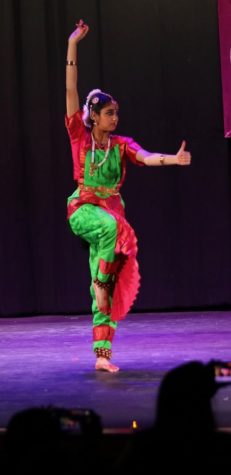South Asian dances display variety of subcultures
April 24, 2023

As the lights shine on the stage, freshman Laksha Muruganandam dances with dramatic expressions and precise movements as a way to convey a meaningful story for the audience. From folk to classical, South Asian dances encompass forms originating from the Indian subcontinent, including countries such as India, Pakistan, Bangladesh and Sri Lanka. Each dance form has a unique origin that is displayed through the dance moves and the meaning behind them.
Bharatanatyam
Having originated about 2,000 years ago from Tamil Nadu, India, Bharatanatyam is one of the oldest classical dance forms. Its origins trace back to the codification of the sacred dance by the sage Bharata in Natya Shastra, an ancient Indian treatise on the performing arts, according to Akademi.
In Bharatanatyam, adavus are the basic steps that form the foundation for the dance, each having a specific name with various forms that follow different beats. Aramandi, a basic sitting position with knees bent, heels pointing towards each other and toes pointing away, is the basic posture for Bharatanatyam, which is present in almost every adavu, according to Bollycurves.
“In class, we start out with adavus so we can practice in order to get the correct steps,” Muruganandam said. “These steps make up the dance because bits and pieces of the steps are incorporated into the dance, and along with our hands, we use these steps to show definition in our songs.”
Many students learn Bharatanatyam for around six to 12 years so that they can perform the Arangetram, which is a solo dance debut. The Arangetram usually takes around three and a half hours with each dance being about 10 to 25 minutes long, according to PennLive.
“Bharatanatyam takes a lot of practice to actually do it properly, especially for the Arangetram,” Muruganandam said. “It does not come out easily at first, and when you learn new steps, it takes practice and a long time to do the dance properly.”
Every song in Bharatanatyam has different meanings based on religious and spiritual ideas. The dance is choreographed based on the meaning of the song, which helps bring out the expressions and hand gestures.
“Many of the songs are based on Lord Shiva and other gods and they sometimes act as a prayer,” Muruganandam said. “In our songs, we have multiple meanings of honoring or showing the gods through these dances so we have to show expressions to portray that.”
Bhangra
Unlike Bharatanatyam, a classical dance, Bhangra is a folk dance originating from the Punjab region in India. Bhangra celebrates the coming of spring as a way for people to enjoy the harvest season, according to Akademi.
The school’s Bhangra Club showcases the beauty of Bhangra through their dance moves and performances. Some moves in Bhangra include kicks, leaps and bends with various shoulder movements.
“I’m in Bhangra Club and I joined it because it was a fun way to connect with my culture,” freshman Rashmika Omtri said. “It looked really fun and there was so much energy. It’s a great way to get exercise and cardio.”
Bhangra dancers wear brightly colored outfits and many accessories. Chunni, a scarf that can be tied around the waist, and a tikka, a traditional piece of head jewelry, are some of the many accessories that decorate Bhangra dancers.
Unlike classical dances which take years to master, Bhangra can be learned professionally or just for fun to perform in parties and special occasions like festivals and weddings.
“I’ve noticed with other dance forms, it takes a few years to learn it,” Omtri said. “But when it comes to Bhangra, anyone can start from nowhere, learn the dance and have so much fun even if they don’t know the basics.”
Kathak
According to Akademi, Kathak started as a form of storytelling of Indian epics in Hindu temples. It is a classical dance that originates from Uttar Pradesh, India. While Bharatanatyam focuses more on hand movements and sitting, Kathak focuses on posture and footwork. Kathak has fluid movements, one basic move is the chakkar, which is a spinning circle or turn.
“In Kathak we have footwork and hand gestures which we use to create a dance,” junior Vedika Srivastava said. “It’s unique because we incorporate a lot of Indian culture and it’s different in terms of spinning and footwork.”
Kathak dancers usually wear a sari, an Indian garment, or a long skirt that reaches the ankle. Bells or ghungroos are worn to emphasize the rhythm of the dance. Alongside bells, dancers wear jewelry such as a choker, long chain and earrings.
“Our traditional Kathak costume is a light Anarkali dress, a dress originating from the Punjab region, with a dupatta, also known as a chunni, and ghungroos,” Srivastava said.
Kathak is found in three forms called gharanas, named after the cities they came from. There are the Japiur, Banaras and Lucknow gharanas. Jaipur gharana focuses on footwork while Banaras and Lucknow gharana focus more on expressions and hand movements.
“I do the Lucknow gharana and they are all similar but each form focuses on something different,” Srivastava said. “The one I do, Lucknow, focuses on todas, tukdas and hastak, which are rotations, basic syllables and hand gestures in Kathak.”
Despite the similarities between South Asian dances, each has an aspect that makes it unique. Even if these dances were founded many years back, as people learn and practice them, the cultural meaning behind them continues to thrive.
“Doing a dance that is true to my culture is really important to me, and I think it helps me keep in touch with my cultural roots,” Muruganandam said. “When we perform, we all have the same goal of doing our best to give the dance justice.”



